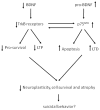Brain-derived neurotrophic factor and suicide pathogenesis
- PMID: 20166812
- PMCID: PMC3708652
- DOI: 10.3109/07853890903485730
Brain-derived neurotrophic factor and suicide pathogenesis
Abstract
Abstract Suicide is a major public health concern. The etiology and pathogenic mechanisms associated with suicidal behavior are poorly understood. Recent research on the biological perspective of suicide has gained momentum and appears to provide a promising approach for identifying potential risk factors associated with this disorder. One of the areas that have gained the most attention in suicide research is the role of brain-derived neurotrophic factor (BDNF), which participates in many physiological functions in the brain, including synaptic and structural plasticity. Several studies consistently show that expression of BDNF is reduced in blood cells of suicidal patients and in brains of subjects who committed suicide. Recent studies also demonstrate abnormalities in the functioning of BDNF, because its cognate receptors (tropomycin receptor kinase B and pan75 neurotrophin receptor) are abnormally active and/or expressed in the post-mortem brains of suicide subjects. There is further evidence of the role of BDNF in suicide as numerous studies show a strong association of suicidal behavior with BDNF functional polymorphism. Overall, it appears that abnormalities in BDNF signaling may serve as an important biological risk factor in the etiology and pathogenesis of suicide.
Figures

Similar articles
-
Brain-derived neurotrophic factor and tyrosine kinase B receptor signalling in post-mortem brain of teenage suicide victims.Int J Neuropsychopharmacol. 2008 Dec;11(8):1047-61. doi: 10.1017/S1461145708009000. Epub 2008 Jul 9. Int J Neuropsychopharmacol. 2008. PMID: 18611289
-
Brain-derived neurotrophic factor: role in depression and suicide.Neuropsychiatr Dis Treat. 2009;5:433-49. doi: 10.2147/ndt.s5700. Epub 2009 Aug 20. Neuropsychiatr Dis Treat. 2009. PMID: 19721723 Free PMC article.
-
The role of brain-derived neurotrophic factor in the pathophysiology of suicidal behavior.Psychiatr Danub. 2013 Sep;25 Suppl 2:S341-4. Psychiatr Danub. 2013. PMID: 23995205 Review.
-
Altered gene expression of brain-derived neurotrophic factor and receptor tyrosine kinase B in postmortem brain of suicide subjects.Arch Gen Psychiatry. 2003 Aug;60(8):804-15. doi: 10.1001/archpsyc.60.8.804. Arch Gen Psychiatry. 2003. PMID: 12912764
-
Brain-Derived Neurotrophic Factor (BDNF): Novel Insights into Regulation and Genetic Variation.Neuroscientist. 2019 Oct;25(5):434-454. doi: 10.1177/1073858418810142. Epub 2018 Nov 2. Neuroscientist. 2019. PMID: 30387693 Review.
Cited by
-
Effects of melancholic features on positive and negative suicidal ideation in patients with treatment-resistant depression and strong suicidal ideation receiving low-dose ketamine infusion.Eur Arch Psychiatry Clin Neurosci. 2024 Jun;274(4):759-766. doi: 10.1007/s00406-023-01735-2. Epub 2023 Dec 5. Eur Arch Psychiatry Clin Neurosci. 2024. PMID: 38052767 Clinical Trial.
-
Identifying rare variants for genetic risk through a combined pedigree and phenotype approach: application to suicide and asthma.Transl Psychiatry. 2014 Oct 21;4(10):e471. doi: 10.1038/tp.2014.111. Transl Psychiatry. 2014. PMID: 25335167 Free PMC article.
-
Brain-derived neurotrophic factor and neuropsychiatric disorders.Pharmacol Rev. 2012 Apr;64(2):238-58. doi: 10.1124/pr.111.005108. Epub 2012 Mar 8. Pharmacol Rev. 2012. PMID: 22407616 Free PMC article. Review.
-
Interaction effects of diabetes and brain-derived neurotrophic factor on suicidal ideation in patients with acute coronary syndrome.Sci Rep. 2022 Apr 22;12(1):6602. doi: 10.1038/s41598-022-10557-6. Sci Rep. 2022. PMID: 35459929 Free PMC article.
-
Creatine, Similar to Ketamine, Counteracts Depressive-Like Behavior Induced by Corticosterone via PI3K/Akt/mTOR Pathway.Mol Neurobiol. 2016 Dec;53(10):6818-6834. doi: 10.1007/s12035-015-9580-9. Epub 2015 Dec 11. Mol Neurobiol. 2016. PMID: 26660117
References
-
- Goldsmith SK, Pellmar TC, Kleinman AM, Bunney WE, editors. Reducing Suicide, A National Imperative. The National Academies Press; Washington DC: 2002. Committee on Pathophysiology and Prevention of Adolescent and Adult Suicide, Board on Neuroscience and Behavioral Health, Institute of Medicine of the National Academies. - PubMed
-
- Minino AM, Smith BL. Deaths: preliminary data for 2000. Natl Vital Stat Rep. 2002;49:1–40. - PubMed
-
- Greydanus DE, Bacopoulou F, Tsalamanios E. Suicide in adolescents: a worldwide preventable tragedy. Keio J Med. 2009;58:95–102. - PubMed
-
- Wasserman D. Negative life events (losses, changes, traumas and narcissistic injury) and suicide. In: Wasserman D, editor. Suicide: an unnecessary death. Dunitz; London: 2001. pp. 111–117.
-
- Ahrens B, Linden M. Is there a suicidality syndrome independent of specific major psychiatric disorders?. Result of a split half multiple regression analysis. Acta Psychiatr Scand. 1996;94:79–86. - PubMed
Publication types
MeSH terms
Substances
Grants and funding
LinkOut - more resources
Full Text Sources
Medical
